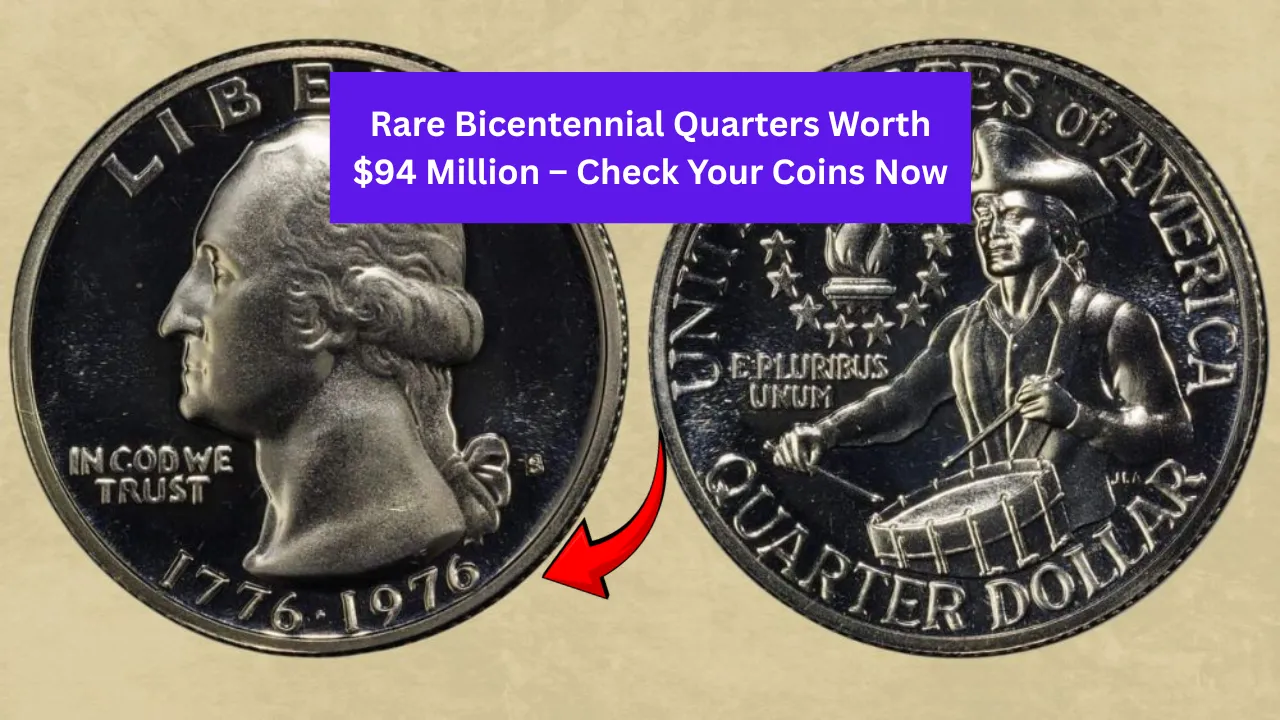You may want to dig through your spare change or that dusty old coin jar—because one of the most talked-about coins in the collecting world is the Bicentennial quarter, and some rare versions are now rumored to be worth up to $94 million.
It sounds unbelievable, but certain rare mint errors and ultra-high-grade specimens of the 1976 Bicentennial Washington Quarter are commanding staggering prices. While most of these quarters are only worth face value, a few rare types have become million-dollar coins for collectors.
Here’s everything you need to know about these rare Bicentennial quarters—and how to find out if you’re sitting on a fortune.
What Is a Bicentennial Quarter?
The Bicentennial quarter was issued to celebrate the 200th anniversary of the signing of the Declaration of Independence. Struck between 1975 and 1976, all coins bore the dual date 1776–1976 and featured a Colonial drummer on the reverse instead of the usual eagle.
They were released into circulation by the millions—but not all were created equal.
Why Are Some Bicentennial Quarters Worth Millions?
While most Bicentennial quarters are common, there are extremely rare types and minting errors that can skyrocket in value. The ones drawing six- and seven-figure price tags typically have:
- Minting errors
- Rare metal compositions
- High grades (like MS-68+ or PR70DCAM)
- Unique characteristics not found in standard circulation coins
A perfect storm of rarity, condition, and collector demand is what gives some coins values that seem straight out of a treasure-hunting movie.
The $94 Million Myth—What’s Real?
Reports of a single Bicentennial quarter being worth $94 million have swirled around online, often fueled by viral articles and exaggerated headlines. While no Bicentennial quarter has officially sold for $94 million, some ultra-rare error coins and unique specimens have sold for hundreds of thousands—and could theoretically reach multimillion-dollar values in private sales.
So while the $94 million number might be inflated or speculative, rare Bicentennial quarters are very real, and they can be worth a small fortune.
Top Rare Bicentennial Quarters to Look For
1. 1976-S Silver Proof Bicentennial Quarter (No “S” Mint Mark Error)
- Estimated Value: Up to $1 million+
- A silver proof quarter struck at the San Francisco Mint without the “S” mint mark.
- Only one known example exists.
- Considered a one-of-a-kind mint error.
2. 1976 Bicentennial Quarter Struck on a 90% Silver Planchet
- Estimated Value: $250,000 – $500,000+
- These were struck on planchets used for pre-1965 coins.
- Very rare and highly sought after by collectors.
3. 1976-D Quarter Double Die Obverse (DDO)
- Estimated Value: $3,000 – $25,000+
- Features clear doubling on inscriptions like “LIBERTY” or “IN GOD WE TRUST.”
- High-grade DDOs are scarce and command big prices.
4. 1976-S Silver Proof Quarter (PR70DCAM Grade)
- Estimated Value: $7,000 – $15,000+
- Ultra-high-grade deep cameo coins from proof sets.
- A perfect PR70 rating is rare and desirable.
5. 1976 Bicentennial Quarter Struck on Foreign Planchet
- Estimated Value: $10,000 – $35,000+
- These errors occur when a quarter is accidentally struck on a blank meant for a foreign coin.
- Usually lighter or heavier than normal, and visually off.
How to Check if You Have a Rare Bicentennial Quarter
Think you have a lucky coin? Here’s what to look for:
Check the Mint Mark
Look under the date on the obverse. The rarest examples are from San Francisco (S) or contain no mint mark at all when one is expected.
Examine the Metal
Standard quarters are clad (copper-nickel), but silver coins have a different edge (no copper stripe) and sound different when dropped.
Look for Errors
Use a magnifying glass to spot doubling, off-center strikes, or other printing mistakes.
Weigh It
A standard clad quarter weighs 5.67 grams, while silver planchets weigh slightly more. Use a precise digital scale to compare.
Consider Grading It
If you believe your coin is rare or in perfect condition, submit it to a professional grading service like PCGS or NGC. This will certify its authenticity and help determine value.
Where to Sell a Rare Quarter
If you strike gold (or silver), consider these selling options:
- Auction houses like Heritage Auctions or Stack’s Bowers
- Certified coin dealers
- Online marketplaces (eBay, GreatCollections)
- Coin shows and expos
Never sell a potentially rare coin without understanding its true value. Get it professionally appraised before parting with it.
FAQs
Q1: Are all Bicentennial quarters valuable?
No. Most are worth face value. Only rare errors, silver proofs, and high-grade examples carry significant value.
Q2: How can I tell if I have a silver Bicentennial quarter?
Check the edge—silver quarters lack the copper stripe seen on standard coins and weigh slightly more.
Q3: Is the $94 million quarter real?
No public record confirms a sale at that price, but rare Bicentennial quarters have sold for hundreds of thousands—and some could be worth millions privately.
Q4: Should I clean my old coins to make them look better?
Never. Cleaning coins can reduce their value. Always leave them in their natural state.
Bottom Line: Your Change Could Be Life-Changing
It’s not every day you find a fortune in your coin jar, but with the right mix of rarity, error, and condition, even a humble Bicentennial quarter could be worth thousands—or more.
The next time you’re handed a quarter, don’t dismiss it. It might just be a $94 million legend in disguise.
